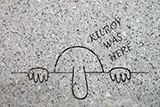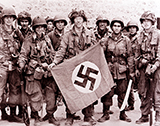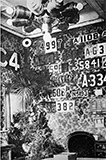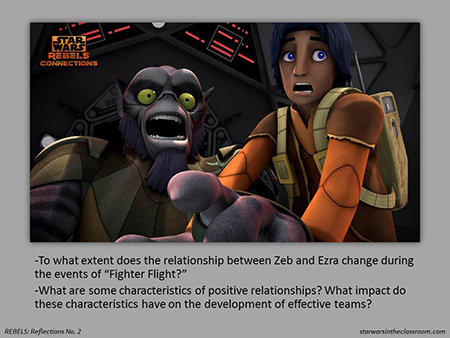 | Fighter FlightSeason 1, Episode 2 | Droids in Distress | Fighter Flight | Rise of the Old Masters |
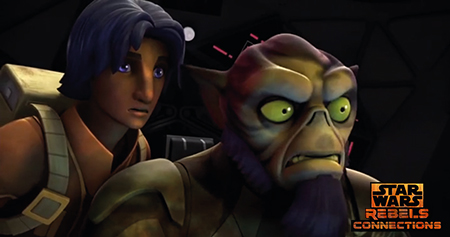
While on a simple errand, Ezra and Zeb steal an Imperial vehicle.
|
Episode Preview |
Graffiti and War
In Star Wars Rebels, Sabine Wren proves to be just as skillful with a can of spray paint as she is with a blaster or explosives. Whether it’s redecorating Ezra and “Zeb’s” room on the Ghost or defacing Imperial propaganda, Sabine possesses an undeniable talent with paint. Her love of art and bright colors is further revealed in her personally decorated Mandalorian armor. Sabine also enjoys tagging a new Rebel insignia each time her crew strikes Imperial targets.
War and artistic soldiers like Sabine are not as unique as one might assume. Soldiers have been leaving behind graffiti, amongst other things, for centuries. Evidence remains of Napoleon’s soldiers at Giza, Egypt where many carved their names in the upper areas of the Great Pyramid. Recently, a couple in Virginia discovered a Civil War soldier’s graffiti in their home. For most of these soldiers, their graffiti served as nothing more than proof they had been there.
Because soldiers often find themselves sitting around and waiting more often than they find themselves engaged in combat, it makes sense that they get bored and sometimes take to doodling or defacing nearby property with graffiti. The images and messages they leave behind can reveal the ins and outs of a soldier’s daily life or they can be sobering reminders of the bitter struggles between people.
During World War II, a popular Allied form of graffiti was “Kilroy.” GI’s would draw the shape of a bald man with a large nose peering over a wall. Scribbled nearby would be the phrase, “Kilroy was here.” There is much debate about where the doodle and phrase originated and what it meant, but the rampant appearances of “Kilroy” around the globe during World War II are undeniable. Occasionally, “Killroy” will still pop up in a public restroom or underpass.
Like Sabine, some soldiers create decorative items out of captured or unused military hardware. This is commonly known as “trench art.” During World War I, many soldiers would use their down time to create souvenirs out of the many things left lying around. Due to the high number of artillery shells used during the war, the spent shell casings became ideal objects for soldiers to modify and decorate.
It’s also important to remember that insignias associated with particular military units likely originated with one or two artistically inclined soldiers. Perhaps the best known combination of art and war resulted in many beautifully drawn images on the fuselages of Allied aircraft during World War I and II.
Sabine Wren, Zeb Orrelios, Ezra Bridger, Galactic Empire, TIE Fighter
- Imperial War Museum- Beauty From The Battlefield: 10 Pieces Of Trench Art
- Canada War Museum
- Soldiers fashioned trench art from the weapons of war as souvenirs of the front
- Va. couple find Civil War graffiti in home
- On the way to Vietnam, soldiers’ graffiti gave voice to their hopes and fears
- Trench Art of the Great War and Related Souvenirs
Soldiers and their souvenirs
As they fly together in a stolen TIE Fighter, “Zeb” presents Ezra with a TIE pilot’s helmet asking, “You collect these, right?” Ezra takes the helmet and replies that he might get Sabine to paint it for him. Although his collection has not yet been seen in great detail, it is apparent that Ezra is saving artifacts from his various escapades.
In war, it is common for soldiers to collect souvenirs of their time away from home. The souvenirs are often military paraphernalia like clothing items, medals, patches, flags, helmets, and weapons. Usually, such objects are acquired from enemy soldiers who left them behind or were either killed or taken prisoner. Sometimes soldiers engage in looting, acquiring a gamut of things from silverware and furniture to cars and priceless art. Napoleon Bonaparte famously stole a large amount of art during his conquests in Italy. Much of this art remains in France.
During World War I, the great aces of the air often collected souvenirs or trophies from the planes they downed. The Red Baron, who had the most confirmed kills at 80, had a particularly expansive collection of souvenirs. His trophy room was filled with small, engraved silver cups he ordered to commemorate each kill. Pilots also collected wing numbers and insignias removed from the planes they had shot down. It wasn’t all for trophy hunting, though, as the pilots often had to produce evidence of the planes they had shot down to confirm their kill count.
Sabine Wren, Zeb Orrelios, Ezra Bridger, Galactic Empire, TIE Fighter
- Stars & Stripes- U.S. troops’ war souvenirs are strictly regulated
- PBS- Spoils of War?
- A Box of WWII Souvenirs Yields a Trove of Nazi Creation Myths
- BBC- Danny Nightingale case: Is the era of the war trophy over?
- World War I in Pictures
Droids in Distress | Fighter Flight | Rise of the Old Masters
Rebels Home
First posted on: December 06, 2014


